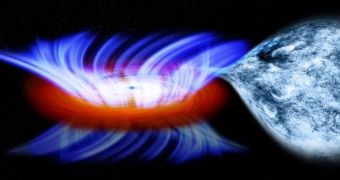A team of investigators reports the discovery of the fastest-moving winds ever found to be released by a stellar-mass black hole. Unlike their supermassive companions, these dark behemoths are relatively small, tipping the scales at only a few times the mass of the Sun.
However, they do release radiations and winds just like their larger brethren, which makes them equally interesting to astrophysicists. In addition, they represent an interesting transition in the history of black hole evolution. The next step is represented by intermediate-size black holes, which are very rare.
In fact, the new investigation is bound to give astronomers a deeper insight into how smaller black holes behave. The fact that their disks can produce winds traveling at such high speeds was not suspected before.
The data that led to this discovery were collected by the NASA Chandra X-ray Observatory. The telescope showed the winds to be moving at speeds of up to 3 percent of that of light, or roughly 20 million miles (32.1 million kilometers) per hour.
This speed is not just slightly larger than the previous record holder, but 10 times as fast. This is a remarkable finding, showing that black hole-induced winds in fact can reach speed ranges that were thought inaccessible to them until now.
For the new study, Chandra was turned on the black hole IGR J17091-3624, which astronomers affectionately refer to as IGR J17091 for short. Usually, a stellar-mass black hole weighs between 5 and 10 solar masses.
The newly-discovered winds are “like the cosmic equivalent of winds from a category five hurricane,” explains University of Michigan investigator and lead study author, Ashley King. A paper detailing the findings was published in the February 20 issue of the Astrophysical Journal Letters.
“We weren't expecting to see such powerful winds from a black hole like this,” the researcher explains. In fact, data show that IGR J17091 is capable of producing winds that travel just as fast as those produced by its supermassive counterparts.
“It's a surprise this small black hole is able to muster the wind speeds we typically only see in the giant black holes. In other words, this black hole is performing well above its weight class,” U-M expert and study co-author Jon M. Miller concludes.

 14 DAY TRIAL //
14 DAY TRIAL //